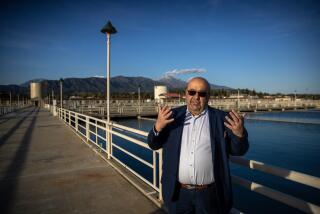San Onofre Worker Awarded $1 Million in Wrongful Firing
- Share via
A former night shift superintendent at the San Onofre Nuclear Generating Station has been awarded more than $1 million in damages by a Vista jury that found he was wrongfully fired by Bechtel Construction Co.
Charles N. Slayton, 44, now a resident of Big Bear near San Bernardino, was an Oceanside resident when he was fired by Bechtel in August, 1984, on grounds that he told a subordinate to take credit for a weld that was made by another worker.
The subordinate complained to Bechtel executives that Slayton had ordered him to falsify records, and Bechtel fired Slayton from his $55,000-a-year job. Slayton had worked for the company for 14 years.
Sensitive Area
Inspected and documented welds are a sensitive area in the nuclear industry because of concern that a shoddy weld could have disastrous consequences. Complaints about poor welding or inadequate weld inspections have sparked numerous investigations over the years by the Nuclear Regulatory Commission and the owners of nuclear power plants around the nation. They also have been the topic of movies, including “The China Syndrome.”
Slayton contended in a civil lawsuit that he did not order the subordinate to falsify records, and by an 11-1 vote the jury sided with Slayton on Thursday in Superior Court Judge Terry O’Rourke’s courtroom.
The jury awarded Slayton $452,331 in general damages and $600,000 in punitive damages.
Appeal Planned
A Bechtel spokesman said the company will appeal.
“We are surprised and disappointed,” said Al Donner, a spokesman for the parent Bechtel Power Corp. in San Francisco. “We believe Bechtel acted properly, and we intend to ask that the judgment be set aside. We are confident that we will be vindicated.”
Carlsbad attorney Lee Landrum, who represented Slayton, said his client has gone without a job since being fired because his career was tainted by the termination.
“Here is a graduate engineer who couldn’t get back into the industry because when job interviewers asked him why he left Bechtel, he had to tell them he was fired,” Landrum said. “He feels he’s been assassinated by Bechtel.”
Weld Questioned
The incident that sparked the firing occurred in August, 1984, Landrum said, when Slayton was approached by a welding inspector who noted that a particular weld had passed inspection but had not been autographed by the welder, who was supposed to write his identification number on the pipe with a felt pen. The weld was on a stairwell pipe within the containment dome of Unit No. 1 at San Onofre, which was inoperative and undergoing extensive structural modifications to meet stricter earthquake safety standards.
Landrum said Slayton instructed his general foreman to order a welding foreman to check the weld and, if it was of the same quality that the foreman himself would have done, for the foreman to sign his own identification number next to it.
Instead, the foreman went to a welding rod inventory room and signed out to himself rods to weld the pipe in question, but he threw away the rods because the weld had already been done, Landrum said.
The rod inventory list is considered the official documentation to tell which welders complete which welds, Landrum said. It was the welding foreman’s own decision to falsify those particular records, rather than to sign his identification number next to the weld itself as Slayton had requested, Landrum said.
Friction Noted
The welding foreman brought the incident to Bechtel’s attention, Landrum said, because the foreman and Slayton did not get along for other, unrelated reasons.
It was Slayton’s position that the welding foreman broke Bechtel’s rules and that he, Slayton, should not have been held responsible for the welding foreman’s decision to falsify records in the welding rod inventory log.
The felt pen autograph next to the welds themselves are not considered the official record of who completed which welds, Landrum said, because those markings are painted over within days of the welds’ completion.
“It would have been a different matter if the weld had not passed inspection and Slayton wanted someone to sign it off as if it had passed inspection, but that wasn’t the case,” Landrum said.
Bechtel’s Donner said that each way of documenting which welders complete which welds is important to the company and is not taken lightly.
“His particular action involved asking another employee to take credit, or ‘adopt,’ a weld that he had not performed,” Donner said. “In nuclear power plants, the procedures for documenting your work--and all the work in the plant--are very well established so that every weld can be tracked to a specific welder. We terminated him for not following those documentation procedures.”
More to Read
Inside the business of entertainment
The Wide Shot brings you news, analysis and insights on everything from streaming wars to production — and what it all means for the future.
You may occasionally receive promotional content from the Los Angeles Times.










